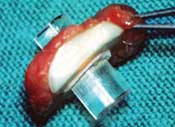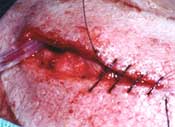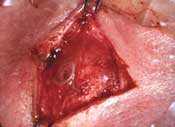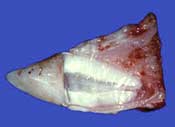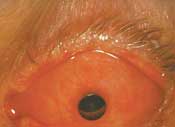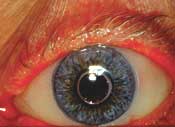Dental corneal prosthesis gaining ground in India
A procedure that utilizes a prosthesis created from a patient’s own tooth to treat end-stage corneal blindness is spreading in India, despite its complexity.
 Srinivas K. Rao |
In 2002, a patient presented at Sankara Nethralaya with severe acid injury to his eyes. The ophthalmologists at the hospital were unable to do anything for this man, but one knew of an ophthalmologist in Italy who was an expert in a two-staged procedure involving a keratoprosthesis fashioned from the patient’s tooth.
The patient was sent to Giancarlo Falcinelli, MD, to undergo the procedure and returned with corrected vision.
The referring doctor, Srinivas K. Rao, MD, had investigated various procedures to treat these severe cases, but the success of this procedure, known as osteo odonto keratoprosthesis (OOKP), led him to introduce the procedure to India.
“That was the final confirmation that this is a good procedure that I need to be doing,” Dr. Rao told Ocular Surgery News in a telephone interview.
The procedure
The procedure is indicated in eyes, such as those with Stevens-Johnson syndrome, in which the ocular surface is keratinized and there is no chance for survival of transplanted tissues, according to Dr. Rao.
“We realized quickly that stem cells have a limit, and there are these bad end-stage diseases which have bone dry surfaces where even the stem cells can’t do much,” he said.
According to experts such as Dr. Rao, head of cornea services at Rajan Eye Care Hospital, who also works at the Darshan Eye Clinic, acid injuries and Stevens-Johnson syndrome are more common in India than many other countries, making this procedure indispensable.
“A lot of these people who have Stevens-Johnson and these acid injuries are young. They are actually in the prime of their so-called economic life,” he said.
The OOKP procedure begins with stage 1, when a canine tooth with a healthy root structure is extracted from the mouth of the patient using a motorized surgical saw.
The surgeon fashions the lamina to be used in the prosthesis by sawing longitudinally through the root of the tooth to expose the dentine and the root canal and then drilling a 3-mm to 4-mm hole to which a plastic cylinder of suitable power is glued.
Meanwhile, a subcutaneous pocket is created in the patient’s cheek. The lamina-cylinder complex is inserted in the pocket with antibiotic powder where it will form connective tissue for suturing.
The eye is managed by releasing the symblephara and excising scar tissue. The surgeon performs a superficial keratectomy including Bowman’s membrane to expose the bare corneal stroma, and a full-thickness circular piece of cheek mucosa is then placed over the cornea and sutured to the sclera.
Stage 2 is performed 2 to 3 months after the first procedure to allow for the connective tissue to develop on the lamina. At this point, the lamina is extracted from the cheek. The mucosal graft on the cornea is incised superiorly and reflected downward from the superior sclera and cornea.
The surgeon sutures a Flieringa ring to the sclera and creates a 3-mm opening in the center of the cornea. The iris is torn at the root and removed with the aid of hypotensive anesthesia, and the lens is cryoextracted.
The surgeon performs a limited anterior vitrectomy, and the lamina is placed over the cornea with the optic cylinder in the anterior chamber and sutured in place using the connective tissue.
Once the cylinder and lamina are in satisfactory position, the mucosal flap is replaced, and an opening is created over the optic cylinder so that it protrudes through the mucosa. The superior edge of the mucosal flap is sutured in place to complete the operation.
Dr. Rao said the procedure is not difficult once the surgeon performs it a few times, but the unusual aspects of the procedure give it a steep learning curve.
“It involves a series of steps that are not normally done by an eye doctor during the course of his surgical training,” he said.
|
|
|
|
|
|
|
Images: Rao, SK |
Sankara Nethralaya
Dr. Rao began learning the procedure under the mentorship of Dr. Falcinelli and his son, Johnny Falcinelli, MD, and by fall 2003 he had performed the first procedure at Sankara Nethralaya, which is the pioneering hospital of the procedure in India.
After Dr. Rao left Sankara Nethralaya, it was the late G. Sitalakshmi, MD, who took over, performing 16 to 18 procedures in 3 years, Dr. Rao said.
Under Dr. Sitalakshmi, the hospital completed 29 OOKP cases, 20 of which have 6 months of follow-up.
Data provided by the hospital showed 15 of those 20 patients improved from hand movement and counting fingers to 6/18 or better at final follow-up.
These results represent a huge leap at Sankara Nethralaya from before OOKP was introduced, according to Geetha K. Iyer, MD, who worked with Dr. Sitalakshmi and succeeded her as the head of the OOKP team.
“As far as Stevens-Johnson syndrome is concerned, we were offering very little in terms of management to these patients,” she said. “We had seen close to 400 patients with Stevens-Johnson ... and we didn’t have anything to offer them.
“[OOKP] was definitely a big boon to us, in terms of visual rehab,” she said.
The hospital now has patients arriving from Bangladesh, Sri Lanka and Malaysia to have the procedure done, and it has developed a special center for OOKP research and surgery called the Professor G. Falcinelli Modified OOKP Center, Dr. Iyer said.
Adopting the procedure
The second center to offer OOKP was the Rajan Eye Care Hospital in Chennai, where they have been working with it for 3 months and have performed the first stage of the procedure on three patients with Dr. Rao’s help and guidance Mohan Rajan, MD, said.
“There is a need for more centers doing this procedure,” he said.
Despite the need, it takes a particular kind of hospital to be able to adopt the procedure, according to Dr. Rao.
“This is not a procedure that can be taken lightly, which everybody can do,” he said. “You do need institutional backup. You need a lot of time. You need subspecialties that can handle the problems that can and do come up.”
For example, Dr. Rao and Dr. Iyer said they prefer to have a dental surgeon on hand in case problems should arise.
“We have a dentist on our panel who helps us out with the evaluation, but we are primarily involved with extracting the tooth ourselves,” Dr. Iyer said.
The OOKP team at Dr. Rajan’s hospital consists of a facial specialist, an anesthetist, two corneal surgeons and four or five nurses, Dr. Rajan said.
In addition, each stage of the procedure can take 6 to 7 hours to complete, he said. With this kind of time required, hospitals need to cushion the costs.
The procedure normally costs US $5,000, but they charge US $500 to US $600 and subsidize the expense for deserving patients with the hospital’s charitable trust, according to Dr. Rajan.
“This is not going to bring you any money, so that is the reason why many institutes and many hospitals are not taking this up,” he said.
Learning OOKP
Unlike other ophthalmic procedures, OOKP is meant only for surgeons willing to put in the time and energy to learn the procedure, and it must be learned on a one-on-one basis, Dr. Rao said.
“Ideally, somebody should do it under the mentorship of somebody who has already done it,” he said.
Dr. Rao said he observed Dr. Falcinelli in Italy and assisted him when he came to India. When they went to Hong Kong, he performed half of the procedures under Dr. Falcinelli.
Ultimately, only a few ophthalmologists and hospitals will be willing or able to learn the procedure, Dr. Rao said.
“Maybe the ultimate way for things to settle would be to have about five good centers spread out over the different parts of the country doing it,” he said.
For more information:
- Srinivas K. Rao, MD, can be reached at Darshan Eye Clinic, T-80 (New No. 24) Vth Main Road, Annanagar, Chennai, India; +91-44-43500003; e-mail: srinikrao@gmail.com.
- Geetha K. Iyer, MD, can be reached at Cornea Services, Sankara Nethralaya, Chennai, Tami Nadu, India; +91-44-28271616; fax: +91-44-28254180; e-mail: drgki@snmail.org.
- Mohan Rajan, MD, can be reached at Rajan Eye Care Hospital, 5, Vidyodaya East II St., T. Nagar, Chennai – 600 017, Tamil Nadu, India; +91-044-28340500; fax: +91-044-28341768; e-mail: rajaneye@vsnl.com.

